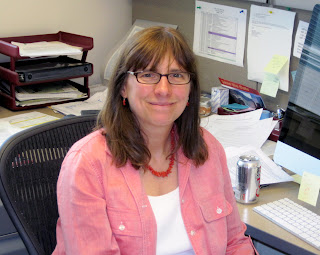By Kirstin Roundy
In the science, technology, engineering and mathematical
(STEM) fields, career progression is similar to the steps of a ladder; you have
to climb the lower steps if you want to advance to the top. However, according
to statistics from the National Science Foundation (NSF), most female
scientists don’t make it to the top of the academic ladder. Although women
represent 41 percent of awarded STEM doctoral degrees, female scientists occupy
only 28 percent of full-time professor positions.
In an academic setting, the basic steps of the ladder are
undergraduate student, graduate student, post-doctoral fellow, assistant
professor and professor. This series of articles profiles female scientists, at
various points in their careers, striving to climb the ladder in the Department
of Pathology at the University of Utah.
Janis Weis – Professor
In the eyes of the NSF, Janis Weis is one of the survivors,
a female scientist who was able to make it through the gauntlet of an academic
scientific career. Weis, however, doesn’t see it as such a miraculous feat.
 |
| Janis Weis |
“You just have to say ‘Well, this is what I want to do, this
is my passion,’” Weis stated. “And then go through and do it.”
For Weis, her scientific career began like many others, with
her formal education. “I took a microbiology class that I just really loved,”
she said. “I thought it was really cool. I had a great Intro to Micro teacher.”
Weis also received guidance from an unexpected source. “I
was taking all the science classes but I didn’t really know what I wanted to
do,” she said. “My mother had a friend who had been a nurse and, as a probably
50 year old woman, she went to graduate school and got a PhD and was doing
research. I went into the lab to visit her and she told me ‘Molecular Biology.’
I said, ‘Oh, this is a vision. This is something I can do.’”
This moment of inspiration led Weis to complete a bachelor’s
degree in microbiology.
After completing her bachelor’s degree, she decided to go on
to graduate school after spending her summer break in a research lab.
“I was supposed to be reading papers and then talking to the
mentor about the things that I read, and I knew I was not the one to just sit
and do the experiments,” Weis said. “I had to be designing the experiments. I
had to be planning the experiments. I knew very early on from that experience
that I had to go to graduate school.”
After graduating with doctoral degree in microbiology, Weis
continued her pursuit of an academic scientific career. For her that choice of
careers was a natural extension of the work that she had been doing.
“All of my role models were my professors. And so that
seemed like that’s what you wanted to do,” Weis stated. “I also saw it as an
opportunity to have so much more control over my life, to choose where I wanted
to live.”
Weis’ scientific interests have remained true to the subject
that inspired her in the first place. “I like thinking about host/pathogen interactions.
From the very beginning, it’s the bugs that make it exciting. That’s the thing
that I think is interesting,” she said.
Her laboratory currently studies the development of Lyme
arthritis. “We’re interested in how Borrelia
burgdorferi causes arthritis and we’re interested in it because not
everybody who gets infected gets arthritis. So we are interested in
understanding how the bacterium causes arthritis and how the host regulates the
response,” Weis stated. “If we can understand what regulates Lyme arthritis, we
may get insights for other inflammatory diseases.”
With regards to the NSF statistics, Weis’ career has
overlapped with the increase in the number of women pursuing scientific
careers.
“There were lots of women in my program in undergraduate…but
when I went to graduate school, I was the only woman in my class. Things were
just opening up,” she said. “[But]
I knew what I wanted to do…If I got sidetracked, it wouldn’t have worked.”
Weis also dealt with making the decision of when to start a
family while still progressing in her scientific career. “Then we had kids. And
that definitely is a sidestep. But I had a six year grant before we had
children,” she said. “And definitely that was a very difficult time. It’s just
really difficult to have kids, to have children. But you just do it.”
However, she also points out the need for continued
vigilance if one wants to have a scientific career and a family.
“The science moves on. If you’re not there to do it, then
either somebody else steps in to do it or your competitors catch up with you,”
Weis stated. “Those are just things that you have to decide. ‘Well, my job is
important to me, my family is important to me so I’m going to do it all.’”
As for the success rates of students and post-docs in her
own laboratory, Weis said that “for the most part, the women have been just as
successful as the men at getting through.” Also, Weis has failed to see a
female scientist be hired at the University of Utah and not achieve a tenured
faculty position.
For Weis, the issue is not the difference between the number
of male and female scientists at an institution. The problem is having enough
funding available for individuals who wish to pursue scientific careers.
“We’re hesitant to encourage anybody to enter science right
now when everybody is so worried about funding,” she said. “So I guess one
thing to encourage people to do, as a scientist, is to engage the public in the
importance of science to continue the support.”
No comments:
Post a Comment